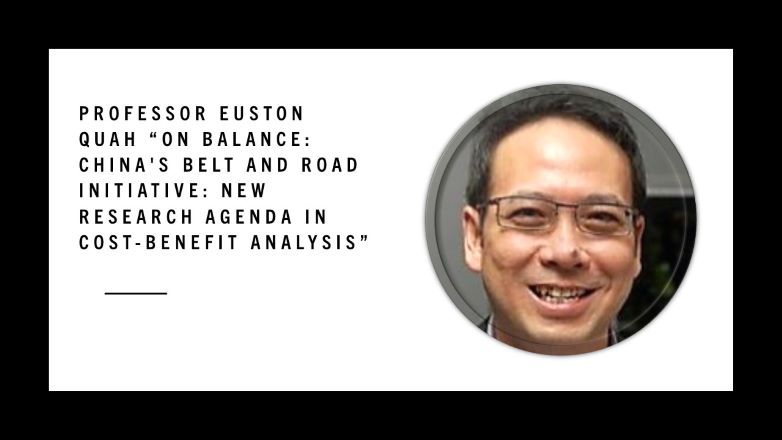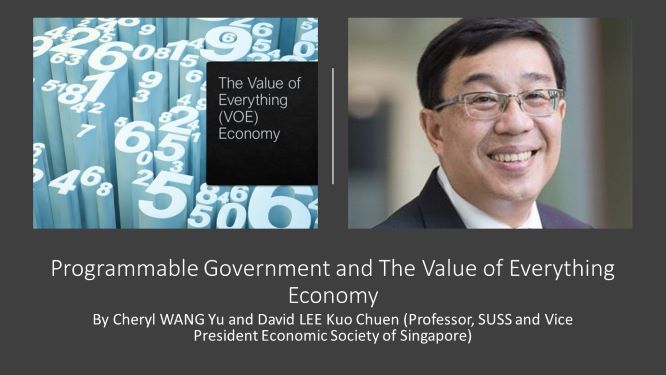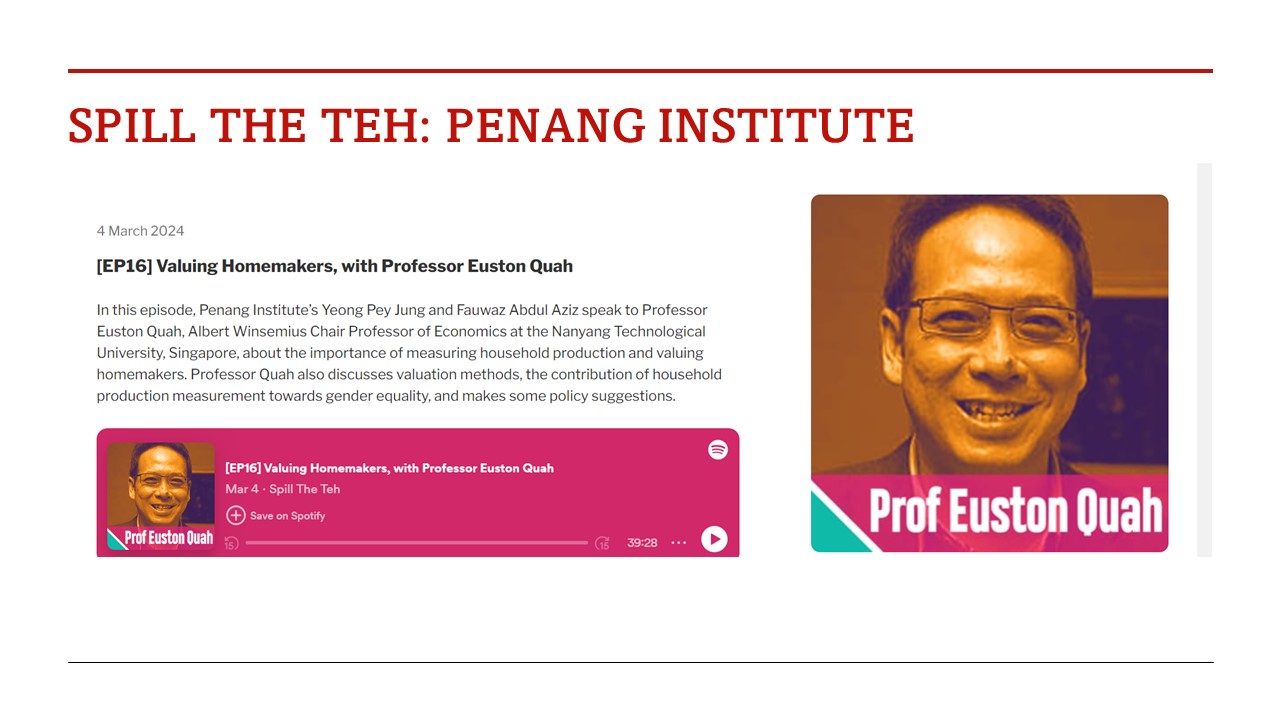China is investing trillions of dollars in hundreds of projects, mainly infrastructures under its Belt and Road Initiative. This Initiative termed the BRI seeks to increase trade and contribute to global economic growth through increased connectivity, ports’ development, building transport networks, pipelines, and other major infrastructures stretching from the northwestern part of China through Central […]
Professor Euston Quah: “On Balance: China’s Belt and Road Initiative: New Research Agenda in Cost-Benefit Analysis

China is investing trillions of dollars in hundreds of projects, mainly infrastructures under its Belt and Road Initiative. This Initiative termed the BRI seeks to increase trade and contribute to global economic growth through increased connectivity, ports’ development, building transport networks, pipelines, and other major infrastructures stretching from the northwestern part of China through Central Asia and Middle East through Africa and onwards to Europe.
We discuss some implications of this BRI in the context of new developments and key challenges it faces, not widely covered in the literature. Specifically, we identified three major areas which require immediate attention if any success of the BRI is to materialize. Such new areas may constitute the new research agenda for Cost-Benefit Analysis. One concern is the issue of NIMBYs (Not In My Backyard) which essentially deals with siting decisions. The second concern has to do with applying Cost-Benefit Analysis to BRI countries and that is whether the framework of conventional Cost-Benefit Analysis remain the same as with applications in developed countries. And, thirdly, the arrival of competing initiatives from the United States and European Union on the BRI. We discuss some conflict resolution instruments to siting issues and the role of auctions. Highlights from the new Health and Digital Silk roads are also presented.
Here are the key takeaways from our presentation at the 2022 Society for Benefit-Cost Analysis Annual Conference:
- Differences between the Ancient Silk Road (ASR) and the New BRI
- New Developments in China’s Health Silk Road (HSR) and Digital Silk Road (DSR)
- The NIMBY Challenge
- Cost-Benefit Analysis in Developing Countries
- New Competing Initiatives and Future of the BRI
The ASR and BRI differ in terms of capital inflow, origin, and scope. For the ASR, there was little capital inflow from foreigners to connected countries; capital accumulation and investment were not practised while for the BRI, there is increased inflow of foreign direct investment from China to BRI countries. The ASR emerged spontaneously, was maintained collectively and by different ruling powers while the BRI was initiated and endorsed by China. Although there were knowledge and technology spread across the ASR, such aspects were not the main use of the ASR, while information exchange and technology sharing are key aspects of the BRI, which are equally as important as trade.
Although the HSR and DSR have existed since the inception of BRI in its conceptual framework, they have gotten much more prominence and spotlight in recent years due to the Covid-19 pandemic.
During the COVID-19 outbreak, some of the transport networks and infrastructure that have been laid by the BRI were utilized to deliver impressive amounts of aid, in the form of medical supplies and antivirus experience to countries in need. Besides the government, Chinese corporations also lent aid to alleviate medical shortages. There is potential for online doctor consultation platforms to be successfully implemented abroad to alleviate overloaded healthcare systems.
The digital economy was also boosted due to the implementation of safe-distancing measures and cross-border e-commerce, with increased demand for digital surveillance solutions such as health-monitoring apps and mobility tracking/tracing. Consequently, demand for telecommunication and digital infrastructure increased, with many opportunities for the emergence of full digital value-chains that are well-established throughout the BRI geography.
Most BRI projects fit the criteria to be classified as NIMBYs. They involve the public sector, generate non-exclusive externalities, and are located in remote areas. Associated costs and benefits are asymmetrically distributed in favor of pollutive NIMBY facilities and end consumers. The wider community’s desire to expand energy facilities that fuel economic growth conflicts with demands by locals residing near the facilities for better quality of life or mitigation of health costs. Following the Green Silk Road Fund, China pledged to reform the BRI including emphasizing on ‘high quality’ green and clean projects that would be inclusive, market-driven, and sustainable. However, much of the promised green reform of the BRI remains challenging as the BRI mostly caters to needs of developing countries which favor more conventional sources of energy.
Six commonly suggested conflict resolution instruments are: local regulations such as bylaws and zoning requirements, licenses and permits, compulsory acquisition of land with market compensation, public hearings and environmental impact assessments, mitigation policies, and general compensation.
The economics literature suggests that active public involvement together with mitigation and compensation actions during a siting decision process would be the most effective strategy overall. Socially efficient compensation systems could also be achieved through different forms of auction mechanism which would site a NIMBY facility in a community which bears the lowest social costs.
The fundamentals of Cost-Benefit Analysis for both developed and developing countries are the same. Cost-Benefit Analysis must be complete, valuations must reflect the true social cost/benefit, time, uncertainty, and equity must be considered, double-counting must be avoided, and transfer payments should be ignored.
However, in applying the principles, it is necessary to be cognizant of the differences between developing and developed countries that might require adaptation of the conventional Cost-Benefit Analysis framework. This is important because most BRI participants are developing countries dealing with the still-evolving financing framework of BRI financial institutions.
Labour, goods, and financial markets differ between developing and developed economies, and these differences may result in erroneous Cost-Benefit Analysis if certain valuation techniques are used. Distortion of cost estimation in developing nations comes from higher level of disguised unemployment, larger information asymmetry and government pricing interventions in the goods market, inflated interest rates due to profiteering by private oligopolistic banks, and higher preference for current over future consumption.
The arrival of recent competing initiatives from the US and EU: Blue Dot Network (BDN) and Global Gateway, were designed to address quality-control, governance, equity, and sustainability risks associated with the BRI. They are thus likely to be competitive alternatives for the BRI.
The many challenges of growing NIMBY Syndrome, difficulties with project evaluation, and application of Cost-Benefit Analysis in developing countries are all the same for the BRI, BDN, and Global Gateway. The infrastructural needs of the emerging and transitioning economies are here to stay. This competition and cooperation between global initiatives will only bolster and transform the future economy, including the built up of digital security, export of technologies, as well as climate-change focused cooperation.
Perhaps, the mutual competition and cooperation will promote structurization and innovation in the use of conflict resolution instruments as well as in valuation techniques, thus providing viable alternatives for participating countries with differing needs.
By addressing these challenges and implementing a successful BRI, China can show the world that the twin goals of economic growth and meeting environmental obligations are indeed possible.


